In the 30 years of its existence, Garmin has proven good at a lot of things, but its mastery of expanding niches into full-blown, must-have products is one reason it’s a $3 billion company. This spring, Garmin resurrected something we thought we’d never see again: the standalone panel-mount GPS. And not just one, but two, one of which represents a new product category.
At the Aircraft Electronics Association show in Palm Springs, Garmin unwrapped the GPS 175, an old-school standalone IFR navigator with LPV approach capability and a companion product that’s something we weren’t sure was even possible, never mind that anyone would want. The GNX 375 combines the standalone GPS navigator with ADS-B In and Out in the form of a Mode-S transponder. It’s essentially Garmin’s hot-selling GTX 345 1090ES transponder mashed together with the navigator. Neither of these units have comm capability, however, so they’re not a straight-up replacement for the GTN-series mapcomms nor a new-age GNS 430/530.
Scouring the Market
You may have noticed that avionics sales have been on a tear recently, with growth into the double digits and eight straight quarters of in-the-black performance, according to AEA. Much of this growth has been driven by ADS-B because as owners haul their airplanes into the shop, they’re doing while-I’m-here upgrades, to include electronic gyros, mapcomms, transponders and so forth.
But Garmin, and probably the shop network that sells their products, discovered a certain resistance among buyers who have modest or older airplanes that have good comms, but who might nibble on a new, color touchscreen navigator at the right price. And at $4995 retail, that’s what the GPS 175 is. Dare we say it, but it’s a modernized throwback to Garmin’s original approach-capable navigator of 25 years ago, the GPS 155/165.
In a market where a $10K box ain’t no big deal, the GPS 175’s price will likely get people through the door. And here’s something interesting: It has the same price tag as the GPS 155 did, but if inflation is considered, that older box would sell for about $8200 in 2019 dollars.

Is Garmin going all consumer electronics on price and volume? Perhaps, but we suspect they’ve set the price to find a broad market to sustain sales when the ADS-B sugar bubble pops by about mid-2020 or beyond. The GTN 650 and 750 were brisk sellers, but nothing like the GNS 430 and 530, thousands of which are still in the field. Moreover, shops say some owners balked at the expense of rearranging the panel to shoehorn in the larger GTN 750.
It’s obvious from the photos that the GPS 175 and GNX 375 share the GTN design architecture and the easy way to describe them is as GTN navigators with the comm sections removed. If there’s canniness to this,
it’s that Garmin sees the size of these new boxes as a critical market driver. Both are the standard 6.25-inch rack width and 2 inches high, or the size of older navcomms like the BendixKing KX155, which is still flying in many aircraft.
The GPS 175 isn’t pin-for-pin on the older navigators it’s designed to replace; it’s a little too complex for that. But it will fit in place of a GPS 155, the old UPSAT GX50/55 and the BendixKing KLN 89/90/94 navigators. As shown in the photo at upper left, the 175 is shallow-only 6.58 inches from the panel face to the rear of the connector backshell. That means it ought to fit into anything without doing major mechanical and electrical violence behind the panel. With that in mind, Garmin also made sure the 175 will work with just about every indicator and autopilot still out there, from old Cessna 300-series autopilots right through the GFC 500. And yes to the BendixKing KI 204/209 and even-gasp-old Narco VOA needles. More modern EFIS gear is also supported, including the Aspen EFDs and Sandel EHSIs.

The interface is straight out of the GTN playbook. It’s a color touchscreen display measuring 4.8 inches on the diagonal and has pinch scrolling and scaling. That’s a little tight on a screen that small, but it’s doable. The 175 has keys and commands identical to the GTN series and has the look and feel of Garmin’s Pilot tablet app.
Speaking of that, both boxes have Garmin’s Connext network that uses Bluetooth to talk to peripherals, including Garmin’s 796/795/660 aera portables and the FltPlan Go app through a tablet. That means you can dump a flight plan from the tablet to the navigator easily. That applies to updating the database with the tablet, too, using Garmin’s Flight Stream 510 in the 175’s memory slot.
Traffic and Weather
As ADS-B reaches its crescendo, Garmin addressed that in two ways. First, the 175 will talk to the GTX 345 1090ES transponders or the GDL 88 UAT box, displaying both traffic and weather from those devices. That includes Garmin’s TargetTrend, which plots vector lines for nearby traffic to help with avoiding when seeing isn’t working.

For owners who don’t yet have ADS-B-quite a few, still-the GNX 375 is simply the 175 with the transponder tacked on the back. That makes it deeper-10.85 inches to the connectors-but everything else is identical to the 175. The transponder is essentially Garmin’s GTX 345, which has proven a killer app in the avionics market thanks to the combination of a good price and reliable installations and interface.
At $7995, the GNX 375 is likely to attract owners who want updated GPS navigation and who’ve been dragging their feet on ADS-B, or so Garmin believes. Garmin said both of these products were expected to be available in April and as an additional pot sweetener, it’s allowing dealers to sell the GPS 175 over the counter so owners can buy it directly and have a local A&P install it. Shops might not like that, but a sale is a sale, and it shows Garmin is ready to compete with Dynon, who’s doing the same thing with a full-up EFIS system.
With the introduction of the GPS 175 and the upscale GNX 375, Garmin has done two things: invented a new product category and come full circle as an avionics company over the course of a quarter century. Oh, and it has left the competition for dead. How did this happen? It hardly seems possible that we once wrote a headline—in 1998—complaining of too many choices in the GPS panelmount market with too little value.
Two years earlier, we reported on seven GPS panel products from five manufacturers. Two decades later, those manufacturers are gone and one is a shadow of what it once was. Garmin did it with an unending parade of new products—some just competent, some spectacular—but mainly because the competition was somnambulant.
Consider the market state in mid1994. Garmin introduced the GPS 155/165 IFR-capable GPS navigators and were the first to gain approach approval. But BendixKing, IIMorrow, Trimble, ARNAV, Northstar and Magellan had credible navigators, even if Garmin bested them on capability.
We assumed the point-counterpoint of competition would distill the best products and consumers would be the winners. It wasn’t to be. Trimble, ARNAV, Northstar and Magellan never developed serious follow-on products, either for lack of will or a belief that the market wasn’t worth the investment. In 1994, BendixKing still owned the avionics market with the vaunted Silver Crown products. Garmin had no navcomms and a limited GPS panel-mount line. But it was a company on the move. In 1998, Garmin unveiled the seminal GNS 430, the world’s first color mapcomm— a word we had to invent to describe it. It wasn’t cheap, either. At $9995, it was the equivalent of $15,500 in 2019 dollars.
The new GPS 175 costs a third of that. Despite the GNS’s high price, the market lost its mind and the 430, and the follow-on 530, fell into a bottomless pit of demand. BendixKing responded respectably with the KLN89B and the KLN94, but compared to Garmin’s sales, these were lesser players. And while it did develop some large-screen displays—the KMD 555 and 850— these were never mainstreamers.
Serious competition came from UPSAT, the former IIMorrow bought by the package company to develop tracking technology for its trucks. In 2003, it introduced the CNX80, an FMS-style integrated navigator that we thought bested Garmin’s GNS 530. Garmin thought so, too, so it bought UPSAT, renamed the CNX80 as the GNS 480 and soon killed it.
In 2004, the battle over integration was joined and won by, surprise, Garmin. BendixKing and Avidyne both attempted integration with modular systems that could or had to use others’ navigators. But that same year, Garmin’s G1000 appeared as the new King Dog of integrated avionics and soon became the de facto standard OEM panel.
Avidyne actually had a simpler, easier-to-use EFIS in the Entegra— or so we thought in a head-tohead review—but Garmin simply overwhelmed it with marketing and support horsepower.
The panel GPS market languished until Garmin introduced the GTN line in 2011. Sales wise, these weren’t as spectacular as the GNS boxes had been, but they were the only new mapcomms around until Avidyne introduced the IFD line, which still gives Garmin some competition.
Because their high price and large size crowded the GTNs—at least the 750—out of many panels, Garmin found an opening: owners with good radios who needed approachcapable GPS and/or mandate-compliant ADS-B. While sales success isn’t a given, it sure looks like just as it did with the GNS series and the G1000, Garmin hit the market with the right product at the right time.
With the introduction of the GPS 175 and the upscale GNX 375, Garmin has done two things: invented a new product category and come full circle as an avionics company over the course of a quarter century. Oh, and it has left the competition for dead. How did this happen? It hardly seems possible that we once wrote a headline—in 1998—complaining of too many choices in the GPS panelmount market with too little value.
Two years earlier, we reported on seven GPS panel products from five manufacturers. Two decades later, those manufacturers are gone and one is a shadow of what it once was. Garmin did it with an unending parade of new products—some just competent, some spectacular—but mainly because the competition was somnambulant.
Consider the market state in mid1994. Garmin introduced the GPS 155/165 IFR-capable GPS navigators and were the first to gain approach approval. But BendixKing, IIMorrow, Trimble, ARNAV, Northstar and Magellan had credible navigators, even if Garmin bested them on capability.
We assumed the point-counterpoint of competition would distill the best products and consumers would be the winners. It wasn’t to be. Trimble, ARNAV, Northstar and Magellan never developed serious follow-on products, either for lack of will or a belief that the market wasn’t worth the investment. In 1994, BendixKing still owned the avionics market with the vaunted Silver Crown products. Garmin had no navcomms and a limited GPS panel-mount line. But it was a company on the move. In 1998, Garmin unveiled the seminal GNS 430, the world’s first color mapcomm— a word we had to invent to describe it. It wasn’t cheap, either. At $9995, it was the equivalent of $15,500 in 2019 dollars.
The new GPS 175 costs a third of that. Despite the GNS’s high price, the market lost its mind and the 430, and the follow-on 530, fell into a bottomless pit of demand. BendixKing responded respectably with the KLN89B and the KLN94, but compared to Garmin’s sales, these were lesser players. And while it did develop some large-screen displays—the KMD 555 and 850— these were never mainstreamers.
Serious competition came from UPSAT, the former IIMorrow bought by the package company to develop tracking technology for its trucks. In 2003, it introduced the CNX80, an FMS-style integrated navigator that we thought bested Garmin’s GNS 530. Garmin thought so, too, so it bought UPSAT, renamed the CNX80 as the GNS 480 and soon killed it.
In 2004, the battle over integration was joined and won by, surprise, Garmin. BendixKing and Avidyne both attempted integration with modular systems that could or had to use others’ navigators. But that same year, Garmin’s G1000 appeared as the new King Dog of integrated avionics and soon became the de facto standard OEM panel.
Avidyne actually had a simpler, easier-to-use EFIS in the Entegra— or so we thought in a head-tohead review—but Garmin simply overwhelmed it with marketing and support horsepower.
The panel GPS market languished until Garmin introduced the GTN line in 2011. Sales wise, these weren’t as spectacular as the GNS boxes had been, but they were the only new mapcomms around until Avidyne introduced the IFD line, which still gives Garmin some competition.
Because their high price and large size crowded the GTNs—at least the 750—out of many panels, Garmin found an opening: owners with good radios who needed approachcapable GPS and/or mandate-compliant ADS-B. While sales success isn’t a given, it sure looks like just as it did with the GNS series and the G1000, Garmin hit the market with the right product at the right time.





